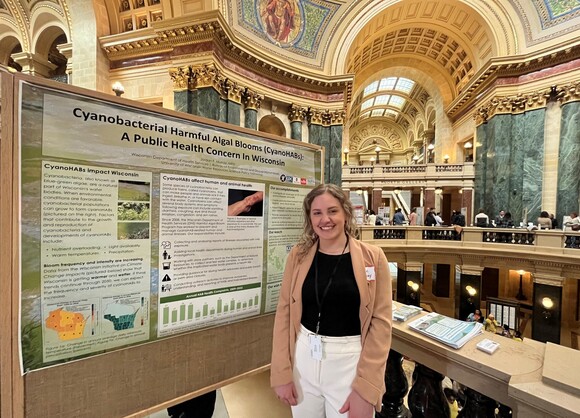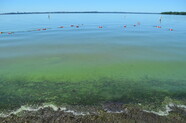
The 2023 Healthy and Safe Swimming Week and Harmful Algal Bloom Season

Happy Healthy and Safe Swimming Week (HSSW)! May 22–28, 2023 marks the 19th annual HSSW. This is a dedicated time for state and local health departments across the U.S. to engage the public, the media, beach managers, pool operators, and owners of residential pools and hot tubs to maximize the health benefits of water-based physical activity by minimizing the risk of waterborne illness and water-related injury.
In Wisconsin, the harmful algal bloom (HAB) season can begin as early as late May, coinciding with HSSW. The DHS HAB Program wants to help you prepare for effective messaging to the public about HABs and water safety, as well as provide you with the resources you’ll need to address blooms and related illnesses. This issue includes a training opportunity, FAQs, and resources to help you prepare for the 2023 HSSW and HABs season.
|
Training Opportunity: Save the Date!
HAB illness and investigation webinar
DHS's HAB Program will be hosting a virtual HAB-related training webinar on June 14 at 11:00am. Local health officials, tribal health directors, public health nurses, and environmental health specialists interested in learning about cyanobacteria and cyanotoxin poisoning and local roles and responsibilities for reporting and investigating these illnesses, are encouraged to attend. Other topics covered in this training will include:
- Health effects from exposure to cyanobacteria and cyanotoxins.
- An overview of Wisconsin's HAB Surveillance Program.
- A case study about DHS's first ever HAB-related illness outbreak.
- A tutorial on using WEDSS to report HAB-related human illnesses.
- Available resources for local officials and the public.
Secure your spot by adding this link to your calendar and be on the lookout for a future reminder!
FAQs
What if I receive a report of a blue-green algae bloom?
If you receive a report of a bloom without an accompanying illness, report the bloom to the Wisconsin Department of Natural Resources (DNR) at dnrhabs@wi.gov. Include descriptions of bloom size, duration, and location with lake, town, and county name, as well as any photos taken both close-up and farther away. The DNR is unable to sample and test in response to each bloom report, but may be able to confirm whether cyanobacteria are present from submitted photos. Please note that this email address is monitored during normal business hours, so responses to reports received outside business hours may be delayed.
What if I receive a report of a human illness suspected of being related to blue-green algae?
Blue-green algae (cyanobacteria) and cyanotoxin poisoning is now a Category II reportable condition in Wisconsin. Cases must be reported to the local public health department or tribal health center of the jurisdiction where the ill person resides within 72 hours of case recognition. Local health departments should report the suspect case to WEDSS as soon as possible and reference the Case Reporting and Investigation Protocol for guidance. Due to the complexity of case investigation and risk assessment, the DHS HAB Program will work with local health and tribal agencies on case investigations. The HAB Program has been investigating suspect cases of HAB-related illness for 15 years and will continue to offer technical assistance, including possible water sampling, to local health and tribal agencies during case investigations.
What if I receive a report of an animal illness suspected of being related to blue-green algae?
Report the suspect case to the DHS HAB Program at dhshabs@dhs.wi.gov. The HAB Program will work with the local health agency to investigate the illness. Animal illnesses suspected of being due to blue-green algae are important to report because they may serve as sentinels for human illness.
Who has the authority to close a public beach or swim area due to a human health hazard (for example, blue-green algae), and when can they do it?
Per Wis. Stat. § 254.46, The local health officer "…shall close or restrict swimming, diving and recreational bathing if a human health hazard exists in any area used for these purposes on a body of water and on associated land in their jurisdiction and shall require posting of the area." Local health departments and tribal agencies have primary authority for issuing health advisories, beach or water body closures, and public messaging. An exception exists for state parks and Great Lakes beaches; at many of these locations, the DNR will post signage and close public beaches.
Local health and tribal authorities can issue a health advisory and close a public beach due to blue-green algae when testing or visual observation suggests a high probability of adverse human health effects (>100,000 cells/mL cyanobacterial cell density, elevated cyanotoxin concentrations, OR a visible cyanobacteria scum layer is present).
Quick links
Signage
Did you know that the DHS HAB Program offers signage for local agencies to post? See below:
 If you would like to purchase a sign, please complete this order form. Completed order forms and questions about ordering should be directed to Megan Rodriguez at Badger State Industries by email or by calling 608-240-5257. Signs are made of high quality aluminum and are offered in 9”x12” and 12”x18” sizes. Metal 6.5’ stakes are also available for purchase.
Note: Only officials at local public health and tribal governmental agencies, and state parks and state forests operated by the Department of Natural Resources, may place an order for these signs. Others who wish to use these signs must coordinate with their local health officer.
Guidance for signage use
Who can post these signs?
Per Wis. Stat. § 254.46, The local health officer "…shall close or restrict swimming, diving and recreational bathing if a human health hazard exists in any area used for these purposes on a body of water and on associated land in their jurisdiction and shall require posting of the area.. Local health departments and tribal agencies have primary authority for issuing health advisories, beach or water body closures, and public messaging within their jurisdictions. An exception exists for state parks, state forests, and some Great Lakes beaches; at many of these locations, the DNR will post signage and close public beaches.
What are the intended uses for these signs?
Scan Before You Swim, Cyano ID, and Caution signs are intended to advise beachgoers and other visitors to a water body about potentially hazardous cyanobacterial bloom conditions. Public access locations (for example, beaches and boat launches) on lakes with a known history of blooms should be prioritized. These signs can be posted throughout the recreational swim season (Memorial Day–Labor Day) but should be removed once the swim season concludes.
Beach Closed signs can be posted when testing or visual observation of a public swim area suggests a high probability of adverse human health effects (>100,000 cells/mL cyanobacterial cell density, elevated cyanotoxin concentrations, or a visible cyanobacteria scum layer is present). Authorities should reference Section IV of the Blue-green Algae Case Reporting and Investigation Protocol and contact the DHS HAB Program at dhshabs@dhs.wi.gov with additional questions and for guidance surrounding issuing beach closures.
Authorities should place their name and contact information on the bottom of the Scan, Caution, and Beach Closed signs.
Protect Your Pets is intended to be posted at dog swim areas throughout Wisconsin throughout the recreational swim season. This sign aims to inform pet owners to be on the lookout for HABs in the water as well as provide guidance for best practices to protect people and their pets from HABs.
Are art files also available?
Yes, approved art files (PDFs) can be requested by emailing the DHS HAB Program (dhshabs@dhs.wi.gov)
Highlights From Recent Events
Wisconsin Lakes and Rivers Convention (4/19 – 4/21)
DHS’s HAB Program Coordinator, Jordan Murray and Statewide HAB Coordinator at the Department of Natural Resources, Gina LaLiberte recently participated in the annual Wisconsin Lakes and Rivers Convention in Stevens Point. This event was part of Wisconsin Water Week, which is a time for people of all ages and backgrounds to learn about what’s happening with Wisconsin's water resources and how lake enthusiasts can be involved in protecting and restoring them.
The Wisconsin HABs Team had the opportunity to educate an audience of lake association members, local health officials, natural resources folks, and lake front home owners about bloom basics. Gina presented on bloom ecology, evaluating bloom treatment and management methods, and actions that can be taken to reduce blooms and protect the health and integrity of Wisconsin's lakes. Jordan supplemented this talk by discussing the health effects from HAB toxin exposure, Wisconsin’s HAB Program and case surveillance data, and a unique human case study.
Select participants also had an opportunity to attend a special 3-hour, educational lake algae and cyanobacteria workshop hosted by Gina. Part of this session included a chance to check out Gina’s “algae zoo”—a unique collection of preserved and live algal species.
Wisconsin's Day at the Capitol (4/26)
Jordan Murray (pictured below) recently presented at "The Day at the Capitol" research symposium which took place at the Wisconsin State Capitol. She had the opportunity to talk to legislators, faculty, the general public, and graduate students about HABs as an environmental and public health concern in Wisconsin and the work DHS does to prevent and manage HAB-related illnesses.

 |
|
Let's Get Social!
|
This issue’s sample post:
 |
|
Happy Healthy and Safe Swimming Week! Did you know the season for cyanobacterial harmful algal blooms in Wisconsin usually begins in May? Warmer temperatures help cyanobacteria grow and form blooms. Remember to keep yourself and your pets out of discolored, scummy water and report blooms and related illnesses to your local health department! |
Stay in Touch
 |
|
Missed a past issue? Previous issues are available on our Resources for Health Professionals webpage.
Email us your burning questions! If others can benefit from hearing the answer to your question, we’ll feature it in a future issue.
Remember that we are always available for consultation on any HAB health-related issue by email or phone (608-266-1120).
|
|